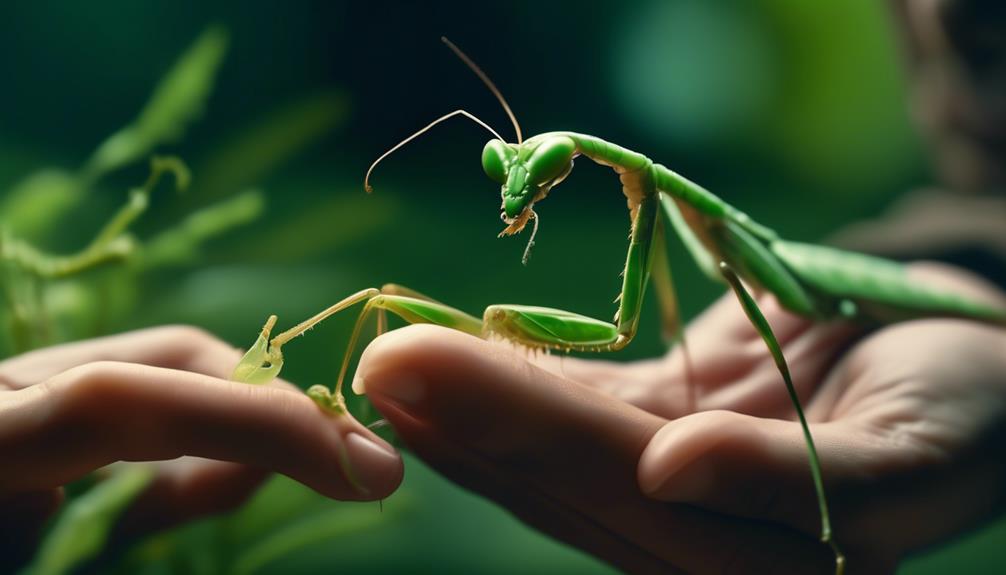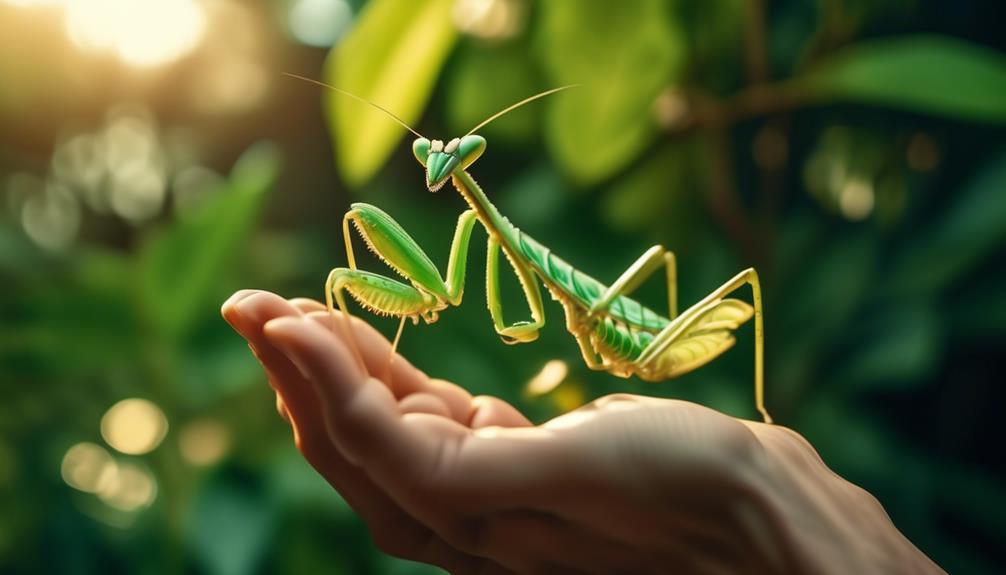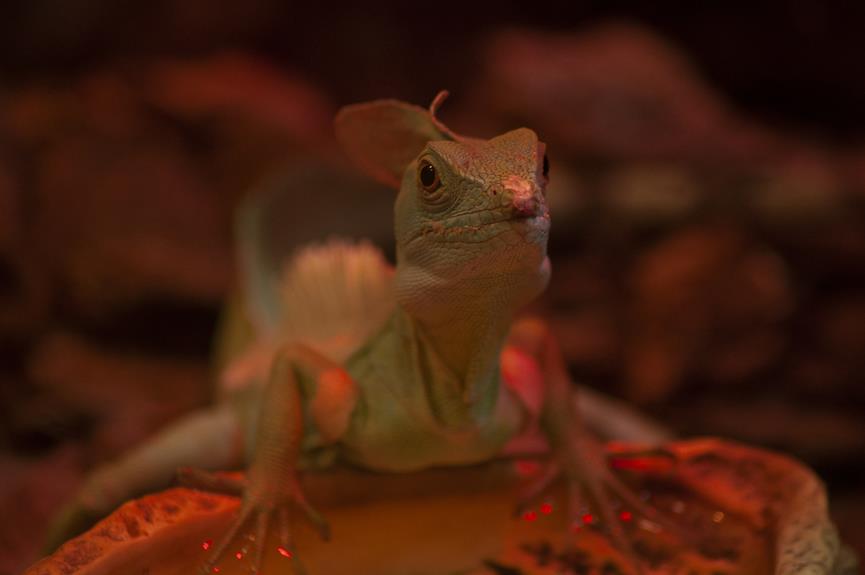As we step into the enchanting world of caring for Chinese mantises, we find ourselves captivated by the intricate dance of their delicate limbs and the mesmerizing sway of their slender bodies. These graceful creatures, with their captivating presence and unique beauty, have long captured the imagination of nature enthusiasts.
But what does it truly take to become a master in the art of caring for Chinese mantises? How can we create an environment that nurtures their well-being and allows them to thrive?
Join us on this journey as we unravel the secrets and intricacies of caring for these fascinating creatures, and discover the joy and fulfillment that comes from providing them with the care they deserve.
Key Takeaways
- Chinese mantises should be housed individually to prevent cannibalistic behavior.
- The enclosure for Chinese mantises should have specific dimensions, with height being three times the mantis length.
- Lighting requirements can be met with natural or artificial light, but additional lighting equipment may be necessary in dark rooms.
- Chinese mantises require a humidity level of 50-65% and should be provided with a source of clean, fresh water.
Housing and Enclosure Setup

To properly house and set up an enclosure for Chinese mantises, it's important to consider their size and specific needs.
Suitable enclosures for juveniles include 32oz deli cups with vented lids, while adults and subadults should be housed in a Kritter Keeper, terrarium, or mesh box measuring at least 8L x 8W x 12H.
Climbing objects such as twigs and thin vines should be provided to mimic their natural habitat. Live plants and artificial foliage can also be included for hiding and to encourage natural behaviors.
It's essential to arrange the climbing objects at various angles to prevent disfigurement. Additionally, leaving an open space at the top of the enclosure allows for molting.
When attaching climbing objects and foliage, use hot glue and avoid the use of soap or disinfectants.
Lighting and Temperature Requirements
Chinese mantises have specific requirements for lighting and temperature in order to thrive and maintain optimal health.
When it comes to lighting, as long as the mantis enclosure receives approximately 12 hours of artificial or bright natural light per day, additional lighting equipment is unnecessary. However, if the mantis is kept in a dark room, a separate lighting equipment for the terrarium is needed.
Temperature regulation is crucial for Chinese mantises, as they thrive between 70-80°F and can be kept at room temperature. It's important to avoid temperatures above 88°F and below 50°F.
To provide a temperature gradient within the enclosure, heat lamps can be used in full-size mantis enclosures, but not with nymphs or plastic-top enclosures. It's advised to use a low-wattage heat bulb and suspend the lamp to prevent burns.
Humidity and Water Requirements

Maintaining proper humidity levels and providing access to water are essential for the health and well-being of Chinese mantises. These delicate creatures require an average humidity range of 50-65% for successful molting and overall thriving.
To achieve and monitor these levels, lightly mist the enclosure with a spray bottle at least once a day, ensuring not to directly spray the mantis to prevent stress. Mesh enclosures may require heavier and more frequent misting.
Additionally, it's important to provide a source of clean, fresh water for the mantises. This can be done by using a shallow dish or container filled with water for drinking purposes. Mist the enclosure with water to increase humidity and provide hydration, but be cautious not to overdo it. Monitoring the water levels and refilling as needed will ensure accessibility for the mantises.
To maintain the appropriate humidity levels, consider using a bioactive soil substrate or other suitable substrate options.
Feeding and Nutrition
Feeding and nutrition are crucial aspects of caring for Chinese mantises. Providing a proper diet is essential for their growth, development, and overall health. Chinese mantises should be fed a diet consisting mainly of live insects, such as fruit flies, house flies, crickets, and small moths. It's important to offer appropriately sized prey to ensure the mantis can consume them comfortably.
Providing a varied diet is also necessary to ensure that the mantis receives a balanced nutrition. It's recommended to avoid feeding wild-caught insects, as they may carry pesticides or parasites. To maintain cleanliness, any uneaten prey should be promptly removed to prevent spoilage. Additionally, nutritional supplements may be necessary to ensure the mantis receives all the essential nutrients.
Following a feeding schedule and providing proper nutrition will contribute to the mantis's overall well-being.
Handling, Maintenance, and Health

To ensure the well-being of Chinese mantises, it's important to handle them with care and maintain a hygienic environment through regular maintenance and observation of their health.
Chinese mantises are delicate creatures and should be handled gently to minimize stress and potential injury. It's crucial to avoid excessive handling and to support the mantis from below when necessary.
Washing hands before and after handling is necessary to prevent the transfer of harmful substances. Regularly cleaning the enclosure is essential to maintain a hygienic environment and prevent bacterial growth. Removing any uneaten prey or debris is important in this regard.
Additionally, it's crucial to monitor the mantis for signs of illness or injury, such as lethargy or abnormal behavior. Consulting a veterinarian experienced with insects is recommended if any health issues arise.
Frequently Asked Questions
What Are the Different Stages of Development for a Chinese Mantis and How Do Their Housing Needs Change as They Grow?
As Chinese mantises progress through various stages of development, their housing needs change. Enclosure size should be adjusted to accommodate their growing size, while providing appropriate climbing objects, hiding spots, and temperature gradients for their well-being.
Can Chinese Mantises Be Kept Together if They Are the Same Size?
Keeping same sized Chinese mantises together is not recommended due to their cannibalistic behavior. Socializing them can result in aggression and death. It is best to house them individually to ensure their safety and well-being.
Are There Any Specific Live Plants or Artificial Foliage That Are Recommended for Chinese Mantis Enclosures?
Recommended live plants and artificial foliage provide numerous benefits for Chinese mantis enclosures. Live plants offer hiding spots, humidity regulation, and a natural environment. Artificial foliage adds visual appeal, climbing opportunities, and enrichment for these fascinating creatures.
How Often Should the Enclosure Be Cleaned and What Cleaning Products Are Safe to Use?
We clean the enclosure of our Chinese mantises regularly to maintain a hygienic environment. It is recommended to clean the enclosure once a week. We use mild, unscented soap or a vinegar-water solution as safe cleaning products.
Are There Any Common Signs of Illness or Health Issues to Look Out for in Chinese Mantises?
Common signs of illness in Chinese mantises include lethargy, abnormal behavior, and lack of appetite. To care for sick mantises, monitor their behavior, maintain a clean enclosure, and consult a veterinarian experienced with insects if necessary.
Conclusion
In conclusion, by following the guidelines and tips provided in this comprehensive guide, you can become a master in the art of caring for Chinese mantises.
Creating an ideal habitat with the right housing, lighting, temperature, and humidity conditions is crucial for their well-being.
Additionally, providing a nutritious diet and practicing gentle handling and regular observation will ensure their health and happiness.
Did you know that Chinese mantises are known to consume approximately 1,000 aphids in their lifetime, making them valuable allies in pest control?

